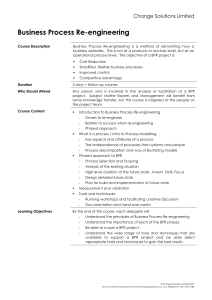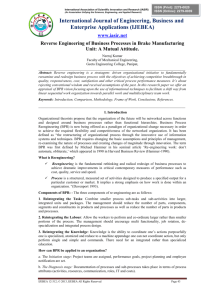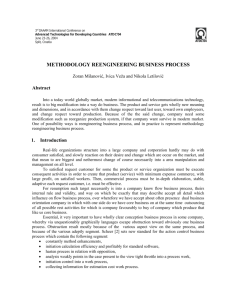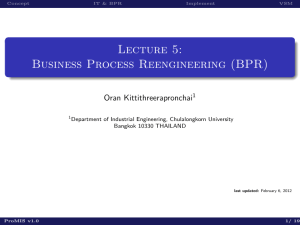ICT612-Topic8-Organisations-and
advertisement
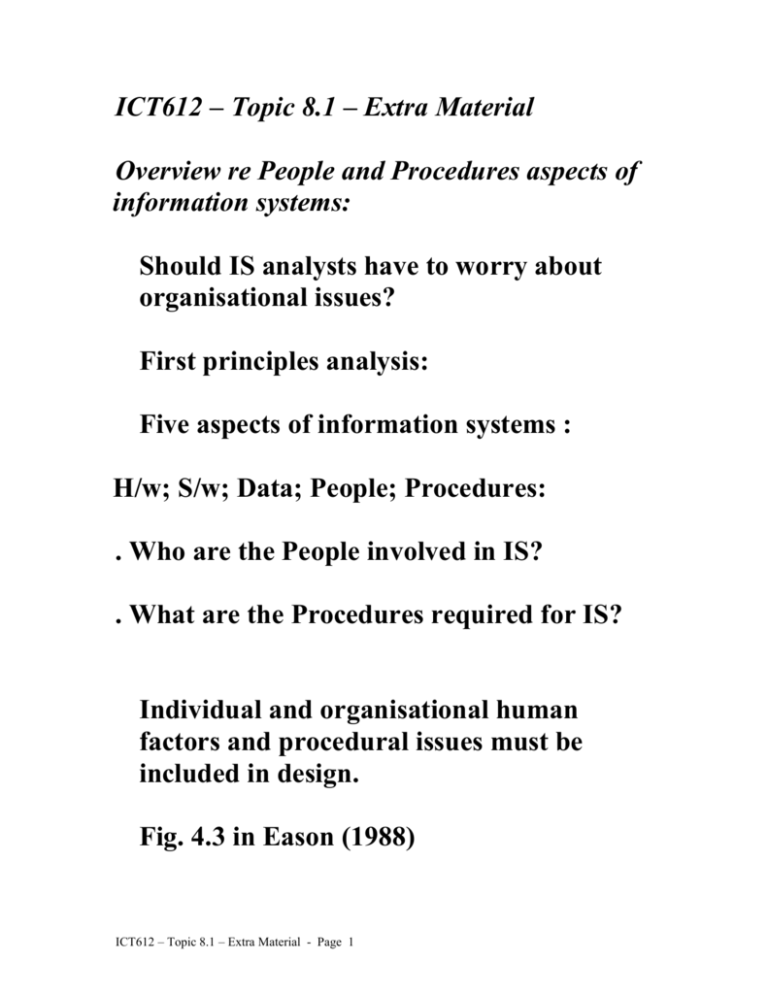
ICT612 – Topic 8.1 – Extra Material Overview re People and Procedures aspects of information systems: Should IS analysts have to worry about organisational issues? First principles analysis: Five aspects of information systems : H/w; S/w; Data; People; Procedures: . Who are the People involved in IS? . What are the Procedures required for IS? Individual and organisational human factors and procedural issues must be included in design. Fig. 4.3 in Eason (1988) ICT612 – Topic 8.1 – Extra Material - Page 1 Flynn (1992) Ch. 12 "The values that shape systems design are also influenced by how powerful groups and individuals believe that people in organizations should behave. For example, there is a difference between seeing people in organizations as skilled and trustworthy and seeing them as unskilled and lazy" (p. 267) " … a Rational Systems approach to organizations assumes that organizational goals are clear, resources are ample, and that organizational members are generally cooperative. Years of research on organizations shows that these assumptions are routinely violated in typical organizations … Computer scientists making important changes in organizations need to have a more complete understanding of how organizations actually behave" (p. 268) ICT612 – Topic 8.1 – Extra Material - Page 2 "Systems design in real organizations is difficult. Diversity within organizations makes system design as much an organizational activity - and thus a social, cultural, economic, and political activity as a technical activity. (p. 268) "Organizational implementation means making a computer system accessible to those who could or should use it, and integrating its use into the routine work practices." (p. 269) "People are more likely to share information when the system helps provide social feedback about the value of their efforts, or when they are rewarded (or at least not punished) for contributing" (p. 269) "People compute in a social world of relationships to others. they are concerned about acceptance, status, resources, power and meaning. ICT612 – Topic 8.1 – Extra Material - Page 3 This "web" of social relationships and technological dependencies extends beyond the formally defined group and organizational boundaries that computer scientists usually rely on as an adequate description of organizational behavior. ... Understanding the use and value of computing requires knowledge of informal social behavior, available resources, and the dependencies between key groups" (p. 269) ICT612 – Topic 8.1 – Extra Material - Page 4 Organisational Theory and Information Systems: Flynn (1992) Ch. 13 Examination of an approach to handling organisational issues within an IS framework. Flynn explains why it isn't easy and the application of a contingency approach, involving various factors: Psychological / social factors; Uncertainty and organisation structure; Technology; Tasks; Power ICT612 – Topic 8.1 – Extra Material - Page 5 Practical recommendations: A way of coping with the complexity of the interaction of factors is to adopt a broad sequential strategy, as follows: 1. Decide on key aspects of appropriate organisational structure, taking into account views of power holders in the process. 2. Decide on appropriate type of information system bearing in mind the goals, tasks, information flows and organisational structure 3. Design the detail of the information system and the user's tasks, roles etc, so that it is congruent with the previous decisions. Some revisions of earlier decisions may be required to maintain coherence/congruency. ICT612 – Topic 8.1 – Extra Material - Page 6 Review of BPR What is BPR? Business Process - Reengineering / Redesign / Review / Reorganisation / etc. Lots of different view points re: . what does BPR mean . rapid vs gradual change . is BPR just good management . use of tools for BPR . cross-cultural issues BPR as reengineering (Hammer & Stanton, 1995) Reengineering not yet a science, but more than an art - a craft. There are no fixed formal procedures or guarantees of success. ICT612 – Topic 8.1 – Extra Material - Page 7 “Reengineering: (The Official Definition) The fundamental rethinking and radical redesign of business processes to bring about dramatic improvements in performance.” (p. 3) - key aspects: dramatic; processes ; radical redesign BPR as Redesign (Kubeck, 1995) - perhaps a more conservative view Various levels (scopes) of intervention: . technology application (narrowest) . work-flow analysis . business process redesign . business reengineering (widest) Relationship of business reengineering to: . software engineering . information engineering . modern structured systems analysis ICT612 – Topic 8.1 – Extra Material - Page 8 Relationship Between BPR and IS Socio-Technical Methodologies BPR as a possible means of integrating IS socio-technical design with business change processes. - Can BPR mean that we only need technical IS methodologies? - Are the BPR processes sufficient from the social point of view? - Are they sufficiently integrated with IS design processes? BPR = “Don’t automate - obliterate!” Is IS part of the problem or part of the solution? A traditional approach to IS development could be seen as reinforcing existing practices (maybe even propping-up fundamentally inefficient ones) rather than enabling radical chance. ICT612 – Topic 8.1 – Extra Material - Page 9 BUT - in cases of successful BPR - IS developments are key facilitating aspects for changes. Key issue is the marrying of IS developments to BPR processes (in the cases where they occur) via an extended concept of the sociotechnical approach. Otherwise IS development and BPR may fight against each other. ICT612 – Topic 8.1 – Extra Material - Page 10 HOW? . integrate IS strategic planning with reengineering; . incorporate IS development activities in reengineering processes; . ensure a flexible approach to sociotechnical IS methods to accommodate BPR practices, whatever form they take; . facilitate radical thinking in IS solutions (when called for); . assist in identification of key areas for improvement; . ensure IS design maximises flexibility for individual workers - so that IS facilitates and/or survives BPR ICT612 – Topic 8.1 – Extra Material - Page 11 Extra socio-technical IS development methodology requirements: . need to address design of full range of procedures required for IS . wide range of people involved with systems - need job descriptions and organisational design . it isn’t easy - option of a contingency approach (inadequate) (Flynn) . why not leave it to the managers to provide needed socio-technical mix? - too hard . need to engage managers and facilitate their involvement - how ? . a key issue is managing organisational interdependence (internal/external) So we are still seeking a method to achieve an integrated socio-technical design process - together with client management ICT612 – Topic 8.1 – Extra Material - Page 12 Designing the organisational structure aspects of information systems: Organisational factors can play a significant role in the optimisation of IS use because they determine who uses the system and the types of tasks performed. Key organisational issues include the following: . design of an organisational structure to successfully integrate IS use with required work procedures; . system implementation and work-role transition strategies; . human resources planning and staff selection, education and training arrangements; . performance evaluation and quality management practices; ICT612 – Topic 8.1 – Extra Material - Page 13 . data sharing and inter-organisation coordination arrangements, including ethical issues relating to validity and confidentiality of information. It is important that the implementation of organisational change and the redesign of procedures and job specifications be carried out with the cooperation of existing staff. This will facilitate the changes in 'organisational culture' required for the successful introduction of IS technology. Special attention needs to paid to workflow and group decision-making aspects, especially where any form of CSCW procedure is introduced. Many of the task analysis procedures required for a thorough approach to organisational design for IS implementation are also required for design of the system's functionality and user interface. ICT612 – Topic 8.1 – Extra Material - Page 14 Hence, the organisational and personnel aspects should be examined within an integrated, comprehensive system development methodology. If the (methodology level) combination of hard and soft approaches (e.g. in Multiview) is not adequate then we need to identify sub-methodology sets of procedures for key aspects of human factors design and ways to integrate them within other methodologies. ICT612 – Topic 8.1 – Extra Material - Page 15

